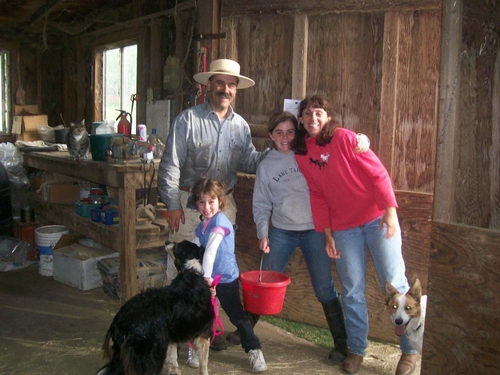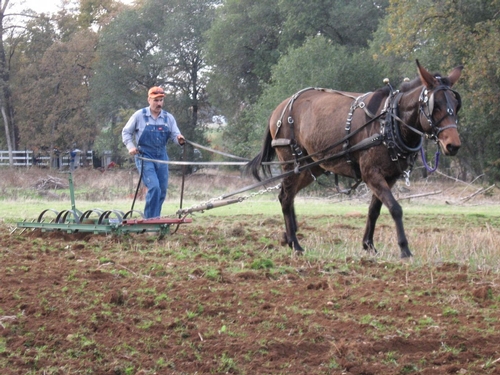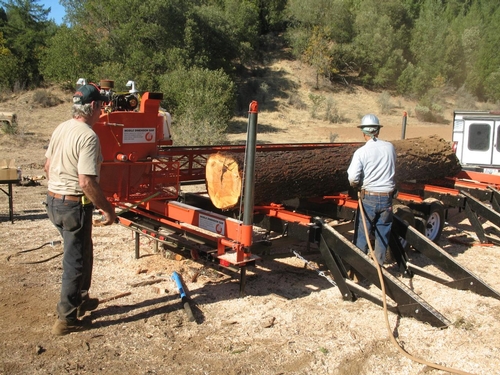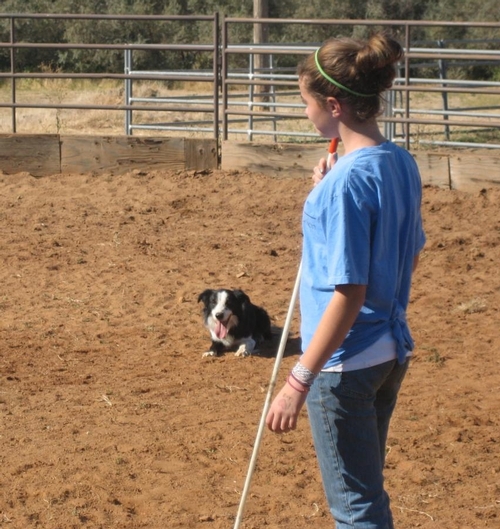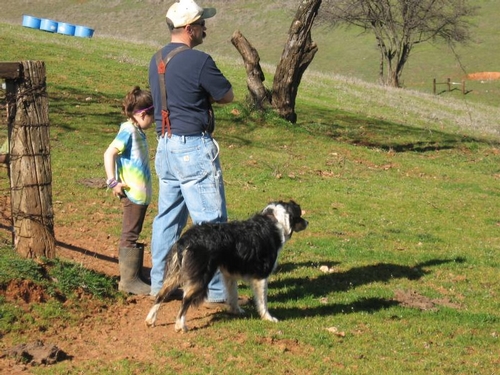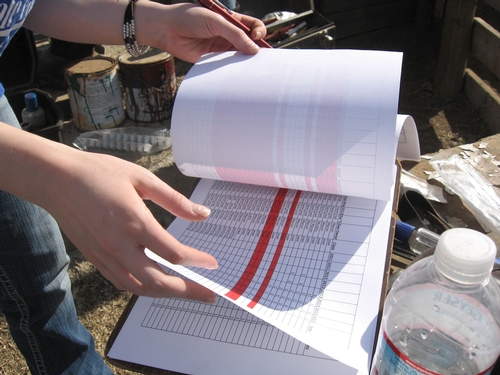Posts Tagged: economics
Small Farm Evolution in Five Easy Steps
Like any small business, small farms undergo a series of transformations during the course of their lives - from youthful exuberance to middle-age crisis to confident maturity (hopefully). Looking at the history of my own farming endeavors, I see that we've traversed at least four evolutionary stages – and we're hopefully headed for a fifth!
The Romance Phase
In the mid-1990s, we raised a handful of cows and feeder lambs. I read many of the key books in the small farm movement (from authors like Joel Salatin, Elliot Coleman and Gene Logsdon). We sold calves when we weaned them in the springtime, and we raised enough feeder lambs for friends and family that we could put a lamb (or two) in our freezer each fall at no cost to us. I served on the board of a relatively new local food organization (PlacerGROWN), and we started raising laying hens and growing vegetables. With a growing family and a dream of creating our own small farm, we purchased 3 acres with 2 barns and a home in Auburn. In the autumn of 2002, I took our first crop (pumpkins and popcorn) to the Auburn Farmers' Market. We also purchased 10 meat goats and more feeder lambs to manage the blackberries and weeds in our pasture. We were on our way!
Looking back, I realize that I didn't know enough to realize that the books I was reading were long on production systems and short on business reality. In many ways, I drank the cool-aid, as my friend and fellow farmer Jim Muck says. Micro farms, like the one I'd just started, were going to save the world from industrial food production. I had no concept about the importance of scale to the future viability of my business.
Experimentation
I'm not sure there's a clear delineation for most small farms between the romance and experimentation phases. For Flying Mule Farm, part of the romance and excitement about starting our farm was the opportunity to experiment with new crops and new livestock. Part of our experimentation was driven by the mistaken belief that we needed to grow everything our customers wanted to buy (and everything we wanted to eat). Specialization and focus was the downfall of industrial agriculture, in my perspective. Diversity was the key – every successful small farm needed multiple crops and several species of livestock. During this phase, we grew spring, summer and fall vegetables (at the peak of our vegetable experiment, we grew on about a quarter acre at home and on another acre of rented land nearby). We started experimenting with greater numbers of sheep, buying 12 Barbados lambs to graze on brush on a friend's timberland. We added meat birds to our chicken flock (our oldest daughter, Lara, reminds us that we butchered chickens – with her help! – on her first day of kindergarten). We sold most of our own brush goats but eventually bought breeding ewes. We leased (and lost – and regained) pasture land in Grass Valley, Lincoln and Auburn during this stage. We tried cutting firewood and milling lumber commercially. And we experimented with the use of draft animals as an alternative to tractors.
In many ways, I loved the experimental phase of our business – especially the outdoor work and our time at the farmers' market. Since we were only at the market seasonally, I still had some Saturdays off. And since our oldest child wasn't yet playing sports on Saturdays, I wasn't conflicted about missing family activities - more on this later!
Wow – this is costing us a fortune! Maybe we need to treat it as a business!
As our knowledge and skill levels improved, we began to see that we needed to treat our farm as a business. We couldn't simply keep growing and raising things without understanding what each crop or type of livestock meant to our economic and financial well-being. The books I'd read didn't seem to emphasize this aspect of farming. And in the back of my head, I began to realize that there were biological limits to the amount of income an acre of vegetables or 100 acres of unirrigated pasture would produce. I started to suspect that we needed to get bigger.
During this stage in our evolution, I participated in the first Farm Business Planning Short Course offered by our local extension office (I've since helped teach this class – now in its eighth year). While I examined all of our enterprises (looking at my economic analysis spreadsheets from that time, I see that we had vegetable, sheep, custom grazing, goats, firewood and other forest products, laying hens and meat chickens). While I was still working part-time, I started thinking seriously about the hourly return to my labor from each of these enterprises. I realized I didn't care for raising meat chickens in large numbers (we raised 500 birds one summer). I also realized that a quarter acre of mixed vegetables (as many as 20 different “crops”) was a large garden rather than an economically viable farm. And I realized that I most enjoyed working with sheep. With this new sense of focus, I decided to quit my “day” job and try to raise sheep as a full time occupation. In addition to leasing pasture around Auburn, we expanded our targeted grazing service (where we'd provide vegetation management services for other landowners). At our peak, we attended 4-5 farmers markets each week – selling grassfed lamb, goat and beef, as well as wool products and firewood on occasion.
As my daughters grew older and wanted to play sports (as I had as a kid), I found it more and more difficult to be at the farmers market on Saturday mornings. On the other hand, we often worked together as a family, which brought tremendous nonfinancial rewards. And we ate well – we traded meat for fruits and vegetables at farmers markets, produced eggs from our own laying hens, raised our own meat birds. But the economics were challenging to say the least.
Why am I still farming? Can I continue?
For me, these questions define the evolutionary stage in which I find Flying Mule Farm today. Several years ago, we came to the conclusion that the farm was taking full-time work on my part, but was paying less than a part-time wage. We exhausted our ability to expand (which had mostly to do with lack of capital and lack of land). I went back to work, and we downsized our sheep operation to fit the time I had available. We started selling whole and half lambs rather than individual cuts – and eventually phased out of the farmers market altogether. I gradually noticed that my motivation for farming was derived not from a desire to feed my community but from my love for working outdoors with livestock. My skills and knowledge base improved to the point where I was confident I could manage the 600-800 ewes necessary to make the ranch a full-time job at full-time pay – but my bank account didn't keep pace. And so today I find myself at a critical juncture – can (and should) I continue farming? I'm struggling with how to answer this question.
Economic Viability = Sustainability
A sustainable farm must be environmentally, socially and economically sustainable. As Flying Mule Farm has evolved, I've begun to think that economic sustainability is the key to the other two elements – a farm that can't stay in business can't provide environmental or social benefits. Based on my experience over the last 20 years, I think that economic viability depends on focused production, appropriate scale, and efficient marketing. I'm still working to get there – on a part-time basis at the moment.
Our farm has been in the midst of its mid-life crisis for several years. I still appreciate the numerous non-monetary rewards of farming – from the gift of new life during lambing season to the opportunity to work side-by-side with my wife and girls. I love the work like nothing else I've ever done. As we enter this new phase in the evolution of Flying Mule Farm, I'll be aiming towards greater profitability. While profit is not the purpose of our farm, it is, after all, necessary for its continued existence. Stay tuned….
Note: Paul Mueller one of the founders and owners of Full Belly Farm, will be joining us for our Farmer-to-Farmer Breakfast on December 3! He'll be talking about how Full Belly Farm has evolved - I can't wait to hear what he has to say! Click here for more information!
The Biology of Farm Size – Or How I Learned to Doubt my Spreadsheets
I'm a spreadsheet guy – I love plugging numbers and formulas into Excel and getting answers! I use spreadsheets to analyze the economics of my business, to predict the amount of pasture grass available for my sheep, and to keep track of orders for my lamb. As a planning tool, spreadsheets can be enormously helpful – but they can also be dangerously seductive. For example, by simply tweaking a single number (like expected lambing percentage), I can turn a projected unprofitable year into a profitable one!
As I continue to think about the question of scale in sustainable farming and ranching, however, I've begun to see the danger in relying on spreadsheets alone. Spreadsheets can tempt us to omit biology from the equation. Let me explain:
There is an upper limit to what an acre of even the most fertile farmland will produce. Based on the yield estimates supplied by Johnny's Seeds, an acre of sweet corn will produce 14,400 ears of corn. Even charging $1/ear, an acre of sweet corn, obviously, won't support a full-time income for the farmer (which is why most local farmers grow more profitable crops). So let's look at a “sexier” (at least according to food writers) crop like kale! An acre of kale will produce 16,275 pounds of harvested product – that's a lot of kale smoothies! My colleague Jim Muck reports that he charges $2 for a half-pound bundle of kale. At that price, an acre field of kale would generate $65,100 in gross revenue – not bad, right?! But wait – aren't there costs associated with growing that acre of kale? Certainly the farmer must put in considerable labor – which has a cost to it. Then there's water, fertilizer, seed, supplies, fuel, marketing costs, storage costs, insurance, land rent (or a mortgage) – that $65,100 in revenue might be offset by as much as $50,000 to 60,000 in direct and overhead costs. In my world, $5,000 to $15,000 isn't enough income to support my family for a year. In other words, the biological limits of my acre of farmland suggest that I need to operate at a larger scale if I want to make a living.
Perhaps livestock operations are different – let's take a look! In our part of the Sierra foothills, an acre of unirrigated rangeland pasture will, on average, grow enough grass to support five mature ewes for one month (these five ewes will need 12 acres of rangeland to get through the whole year). One acre of irrigated pasture will support my five ewes for six months. If I do everything right in caring for my ewes, these five sheep will give birth to 8-10 lambs. If I finish these lambs and sell them as meat at the farmers market, I'll gross $2,400 to $3,000 – all from my acre of land! Just like my friend the vegetable farmer, however, I'll have expenses – things like processing charges, transportation, insurance, land rent, water, veterinary costs, and supplemental feed costs. My net income – which pays my “salary” – is $300-500 from these 8-10 lambs. Once again, biology suggests that I need to operate at a larger scale.
Spreadsheets make it dangerously easy to manipulate these numbers and projections. If I can boost my projected yield of kale by just five percent, it makes my bottom line look much more attractive! Unfortunately, these biological limits don't allow us to fudge our numbers that much. Size, as it turns out, does matter (at least economically).
Don't get me wrong – I'm not advocating for huge monoculture farms. I do think, however, that the romantic notion of micro-farming (less than 2 acres) – the darling of our local food movement – is not the answer, either. If Auburn (for example) needs 25 pounds of kale per person to satisfy local demand for kale, the community would need to grow just over 22 acres of kale. Would 22 1-acre kale farms (none of which would be paying its owner a living wage) be more sustainable, or would it be better to have one or two kale farms that paid the farmer a reasonable annual salary? In other words, do we want a local food system that requires farmers to subsidize their farms with outside income and/or unpaid labor, or do we want a system that is economically viable for consumer and farmer alike? I worry that we may be creating a farming system that requires its farmers to have another source of income (like an off farm job or a retirement fund) in order to keep farming – such a system means we won't likely see young families able to start farms that will be viable over the long term.
I still use spreadsheets in my ongoing attempts to look at the economics of my business, but I've realized that the allure of adjusting the numbers until the farm looks profitable is dangerous (at least for me). My future spreadsheets will begin with the parameters set by the productivity of my land – there is an upper limit to what my soil can produce. My projections must be anchored in reality – and informed by my experience and the experiences of my fellow farmers and ranchers. My spreadsheets must take biology into account!
How Small is Big Enough?

Small is beautiful, E.F. Schuacher tells us, and Schumacher’s vision of economics at a more human scale certainly resonates with me as a small-scale farmer. From a local food perspective, small farms are held up as a more compassionate, sustainable and responsible alternative to corporate-managed industrialized agriculture. Small, family-owned farms, the theory goes, are more ecologically sensitive than their “industrial” counterparts. As a practitioner of “small” farming, I am philosophically and economically inclined towards this perspective. As someone striving to make my living from small farming, however, I often struggle with the question of scale. Balancing the idealistic goal of staying small with the realistic need to be big enough to earn a living wage is, I think, one of the most critical questions for small farmers.
From a practical standpoint, there are advantages to staying small. On a small farm, the farmer can pay close attention to details that might be lost on a larger operation – details like soil protection and pest detection. Wendell Berry writes that a farm is sized correctly if it can be cared for by the farm family and perhaps by a few seasonal employees. Obviously, this definition means that a right-sized farm will vary depending on the crops produced. For example, our family can properly care for 400 ewes with a minimum of outside help. On the other hand, five or ten acres of vegetables might be the correct size for another operation.
Perhaps by necessity, smaller-scaled farms also have more direct contact with their customers. With fewer units to sell, small farms are driven to maximize their profits per unit, which often means direct marketing. This direct connection means less time between harvest and consumption, which allows small farms to market fresher, better tasting, and more nutritious fruits and vegetables. As a small farmer, I focus more on feeding my neighbors and my community than on the oft-repeated focus on “feeding the world” espoused by the proponents of industrial-scale agriculture.
The romantic notion of making a living from 100 ewes or an acre of mixed vegetables, however, quickly runs up against the realities of scale. Small producers typically have higher unit costs for purchasing supplies, obtaining processing services, transporting products, and other inputs. In some cases, these higher unit costs on the expense side of the ledger partially or totally offset the higher per unit revenues that result from direct marketing. In other words, I receive more per lamb marketed than my large-scale counter parts, but my expenses per lamb are greater as well. Size is related directly to costs. For example, the harvest cost for a lot of 19 lambs is $25 per animal. For 20 lambs, I only pay $20 per animal. A semi load of lambs (400 or so), would cost even less to process. Similarly, a bale of alfalfa costs $14 at our local feed store. If I buy a ton of alfalfa, I save 10 percent. If I purchase a truck and trailer load, the hay costs just $8.50 per bale, and it’s delivered to our place.
Finally, scale matters to customers, too. Buyers like restaurants and retail grocers would generally rather purchase food from a handful of sources rather than from a greater number of small farms. The Farmers Diner, a small New England chain of restaurants committed to buying from local, small-scale producers, can’t afford to pay $7.50 per pound for bacon from a farmer just down the road (the price the farm received for bacon at the farmers’ market). Says Bill McKibben in Eaarth, what Farmers Diner owner Tod Murphy “really requires is not huge commodity producers or small, incredibly wonderful gourmet farms.” Murphy tells McKibben, “What I need are 1950s-size farms” – the mid-sized farms that have disappeared in the last 30 years.
Economically, a farm is “profitable” if its revenue per unit sold is greater than the direct costs of producing each unit. For me, I earn a profit if I can sell my lamb for more than the cost of feed, veterinary care, shearing and processing. Once a farm can sell each unit at a profit, the farm family must determine its total income needs (for things like living expenses, overhead costs, health care, retirement, etc). Is the farm a part-time occupation? Does the family need to derive one or more full-time salaries from the operation? In other words, the farm must operate at a scale that covers its production expenses and its overhead, and that produces a profit for the farm family. While this scale varies by the type of operation and by the farm family’s needs and expectations, it is a question that must be answered correctly for the farm to stay in business.
Our primary activity is the production of grass-fed lamb. We started our business with 27 ewes in 2005. Today (2011) we have approximately 100 ewes. Experience suggests that I could manage 3-4 times as many sheep without a significant increase in labor or land expenses. Economics analysis suggests that 400 ewes would produce enough lambs to generate both a salary for me and a profit for the business. My conclusion is that we are not yet operating at the proper scale, given our goals and financial needs.
While small farms may represent a way to invest labor (instead of or in addition to capital), capital costs take center stage when considering any expansion. The typical return-on-investment analysis is not a sufficient gauge of success on its own. As a small farmer, I don’t have much capital to invest in my operation. I do have my time, knowledge and skills, however. Consequently, I’m far more concerned with how much a specific enterprise or activity will return per hour of my labor. That being said, once I’ve learned the skills necessary for an enterprise, it may make sense to invest enough money to increase the scale of our operation.
Much of the solution lies in making our national food system more equitable to those who produce our food. “We need to be willing to pay our neighbors enough to grow our food that they can make a decent living,” says Bill McKibben (Eaarth, p 178). To be sustainable, agriculture must address three key elements: resource conservation and enhancement, social equity, and economic viability. To ignore any of these three issues is short sited; to ignore economic viability is lethal. A farm that fails economically will ultimately fail to conserve resources and social equity. Ultimately, economic viability requires farms to operate at a scale that provides for profitability.
Posted by Dan Macon, Flying Mule Farm


